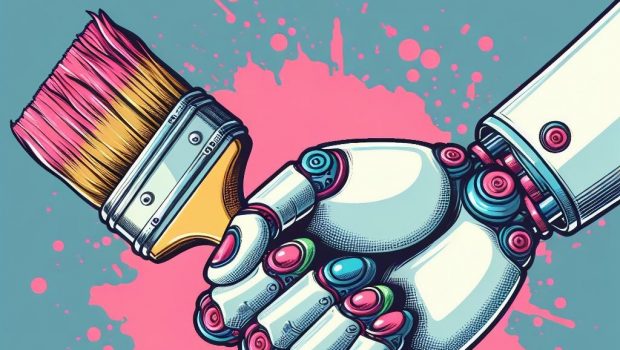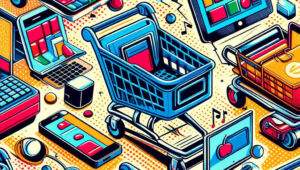Creativity in the Age of Generative AI: How Does Ad Tech Benefit?
by on 10th Apr 2024 in News

Amid the generative AI revolution, how are advertisers using the new tech to enhance creativity? We explore how AI is being harnessed, and how ad tech is benefiting.
The Generative AI Revolution
With its explosive growth over the past couple of years, generative AI has been transforming the face of creativity, and what it means to be creative. From images to music, creating content is becoming much more accessible to both individuals and brands/companies. Content which once required extensive time and tools to be brought to life can now be produced in a matter of moments.
Generative AI offers us an incredible opportunity to enhance our productivity. Studies have shown that using ChatGPT to help with writing tasks can make the work more productive, efficient, as well as enjoyable for those completing it. On a larger scale, McKinsey's calculations predict that generative AI’s impact on productivity could add trillions of dollars in value to the global economy.
Reimagining Advertising
For the advertising industry, generative AI is so far proving to be an impressive tool. Thanks to it, advertisers are able to reimagine the possibilities for a creative campaign. As of March last year, 73% of US marketers were already using generative AI tools as part of their company’s work.
Speed is cited as one of the major benefits of generative AI adoption, along with cost efficiency. The reduced cost is particularly important for the marketing efforts of the nonprofit sector: recent research involving 4,000 organisations found 75% of nonprofits say generative AI has the potential to transform their marketing efforts. However, two-thirds of nonprofits reported a lack of familiarity with generative AI tools was their biggest barrier to adoption, with 40% saying nobody in their organisation was educated in AI. Despite generative AI’s rapidly increasing adoption across many sectors, there is still a lack of knowledge about how it can be harnessed effectively.
Too Good to be True?
Of course, there are also drawbacks. Some worry that human creativity itself is under threat. How and where will we draw the line between what should be done by a human versus a machine? What will society’s limit on automation be? Those in the creative industry particularly worry that their jobs are at risk, with AI models now able to produce copy just like a person and create visual art at much faster speeds than artists who have spent years perfecting their craft. With many lower level jobs now being done by AI, it may also be getting harder for young people to gain experience.
As AI generated content becomes increasingly common, questions surrounding copyright emerge. Doubt has been cast over the rights of those training AI models with copyrighted content: The New York Times recently sued OpenAI and Microsoft for allegedly using the publication’s content to train their AI models, and Nvidia was also hit with a lawsuit over its use of AI copyrighted books to train its NeMo AI model. On the flip side, the UK Supreme Court confirmed that AI cannot patent inventions, which begs the questions: who owns content generated by AI – and should it be owned by anyone?
Harnessing Generating AI
So, what are the most common ways generative AI is being harnessed by the advertising industry and what are the opportunities for marketers?
Written Content
Many advertisers are harnessing chatbot tools such as ChatGPT at different points throughout the creative process. A large number of advertisers use such AI tools at the first stage of the writing process, to help gather ideas. It is also being widely used to create all types of written content from marketing copy and social media posts to ad scripts.
Image and Video Creation
Generative AI image creation has opened many doors, allowing advertisers to immediately actualise their vision. As a starting point, generative AI tools can be used to rapidly create mood boards and colour palette ideas, or any other visual aids which can shape the direction of a campaign or branding. Images for campaigns can be made too, with generative AI image creation tools allowing advertisers to bring to life any image they desire.
Tools such as OpenAI’s Sora now also give advertisers the opportunity to personally bring to life videos in their desired style. Short films have already been made using the tool, and OpenAI has meetings scheduled in LA with Hollywood studios, media executives, and talent agencies, intending to form partnerships in the entertainment industry and encourage filmmakers to integrate Sora into their work.
Hyper Personalisation at Scale
Harnessing generative AI allows advertisers to unlock a new level of personalisation in efforts to increase customer engagement. Leveraging real-time data insights and analysis techniques, advertisers can display the right ad at the right time, delivering users a highly personalised experience. Data analysis itself can be augmented through generation AI, while forms of advertising such as dynamic creative optimisation (DCO) can harness the technology to optimise a campaign’s visual creatives.
Through dynamic creative optimisation, advertisers are able to rapidly create new creatives on a massive scale. By speeding up the production process of the creatives, advertisers will have more time to test and further optimise campaigns while they are still live.
Striking a Balance
Amid the fearmongering that AI is going to replace us all, it’s important to keep in mind that generative AI is a tool designed to assist rather than replace us. AI can be used to enhance our own ideas, content, and art. It can be used as subtly or as noisily as the user wishes. We can use it as a starting point, or even as a finishing point – but it does not need to dominate the entire creative process.
Generative AI is already instrumental in automating advertising campaigns, from efficiently managing scale to rapidly producing the required creatives for continued campaign optimisation. Largely, generative AI can be used to optimise almost any process which is a bit mundane, monotonous, or difficult – and this leaves us more time to get creative. As using generative AI in forms such as image and written content creation becomes more of a norm, advertisers would be wise to work on striking a balance between harnessing the tool and not drowning out their brands’ own voice.








Follow ExchangeWire